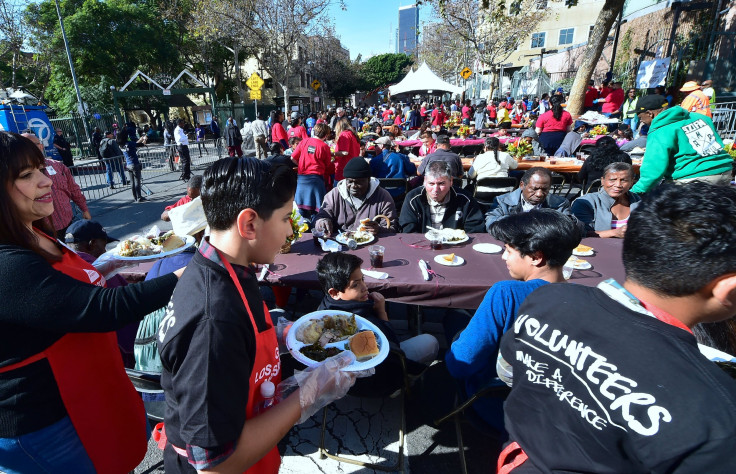Want To Volunteer On Thanksgiving? You May Want To Wait For The Summer Instead

The holiday season can bring out the best in charitable Americans, with many offering to lend a helping hand at food banks and soup kitchens. The spirit of giving can be seen this week when thousands around the country donate their time and efforts on Thanksgiving.
But experts say volunteers can sometimes be more of a nuisance than a benefit. During Thanksgiving and Christmas, there can be the literal problem of "too many cooks in the kitchen," when paid professionals at food banks and soup kitchens expend more time instructing a deluge of volunteers than actually feeding the hungry.
Well-intentioned volunteers would be doing millions of hungry Americans a helpful service in bookmarking their feelings of generosity for other dates when volunteerism isn't at its peak.
“If you really want to volunteer, pick any day, but don’t pick Thanksgiving or the day after Thanksgiving,” Eileen Heisman, CEO and President of the National Philanthropic Trust, told USA Today last week.
The Los Angeles Times reported in 2013 that up to 50 volunteers were turned away on Thanksgiving and quoted a skid row mission spokesperson who said getting an invitation to volunteer is "like getting a concert ticket. You have to sign up as soon as it's posted."
"One way to look at it is it's not there's too much attention in November and December — there's just too little attention the rest of the year," Jim Weill, president of the non-profit national anti-hunger advocacy group Food Research & Action Center (FRAC), told International Business Times in a phone interview.
At the very least, the urge to volunteer on Thanksgiving can shed light on hunger in the U.S., an issue that remains a growing concern. According to the U.S. Department of Agriculture (USDA), there are 41.2 million Americans who live in "food insecure households," meaning there has been uncertainty over how they will acquire their next meal.
Instead of volunteering, Americans can offer a financial donation to a number of non-profits committed to reducing food insecurity. On top of the many local food banks, Feeding America, Share Our Strength and Feed the Children are just a few national organizations that help slow food insecurity in the U.S. The three groups work closely with FRAC, which also accepts donations, to help achieve "a hunger-free nation."
Private-donor funding this year might also be more important than previous years.
Meals on Wheels, an organization that delivers food to senior citizens, came under assault by the Trump administration in March, when White House budget chief Mick Mulvaney said that it is "just not showing any results."
However, an April 2013 review of home-delivered meals, which helps the roughly 5 million seniors who are food insecure, painted a starkly different conclusion.
According to the National Center for Biotechnology Information, "home-delivered meal programs improve diet quality and increase nutrient intakes among participants. These programs are also aligned with the federal cost-containment policy to rebalance long-term care away from nursing homes to home- and community-based services by helping older adults maintain independence and remain in their homes and communities as their health and functioning decline."
David Tabak, Executive Director for Meals on Wheels Chicago, says that nearly every non-profit raises a bulk of their private donations during the holiday months. "It's just the time when people are thinking about being generous," Tabak told IBT.
He added that it can be worrisome for non-profits to rely so heavily on a two-month giving period.
The Trump administration has also targeted school food programs. Mulvaney claimed that there is "no demonstrable evidence" that helping feed hungry students improves their academic performance.
There are 6.5 million children living in food-insecure households, so neglecting the summer months can have far-reaching consequences for children.
"Hunger in the U.S. doesn't peak around the holidays. It peaks in the summer when kids aren't in school receiving school lunches and school breakfast," said Weill.
Roughly 12.3 percent of households, or 15.6 million people, were food insecure at some time during 2016, according to the USDA. The numbers were only a slight improvement from 2015 (12.7 percent).
Weill added that food insecurity remains a serious a "year-round" problem.
"And we need serious year-round solutions to solve it."
© Copyright IBTimes 2024. All rights reserved.





















